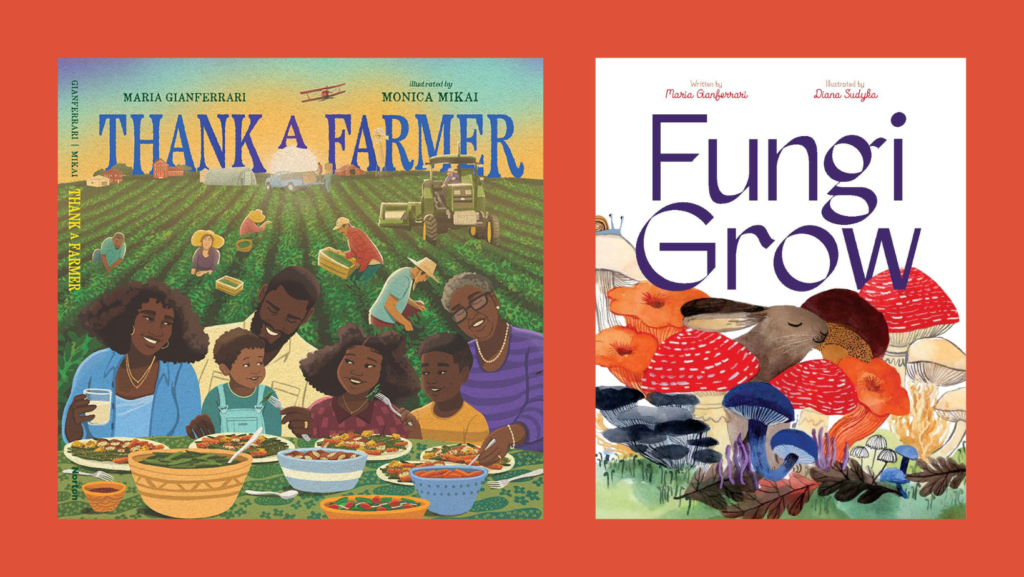
Today’s picture book bounty is a double feature of new books by Maria Gianferrari: Thank a Farmer (illustrated by Monica Mikai) and Fungi Grow (illustrated by Diana Sudyka). Before my interview with Maria, here are quotes from a few reviews:
“Rooted in gratitude, this educational title explains in simple yet comprehensive terms how animal products and foods move from farm to table. Narrating in free verse, Gianferrari succinctly compresses complex farming, production, and supply chain processes into easy-to-follow lines, inviting readers to learn about the origins of bread, cereal with milk, salad and veggies, and other favorites.” ~ Publishers Weekly, starred review [Thank a Farmer]
“From produce and bread to clothing and sweets, the favorite items that farmers bring to tables and homes. …A valuable look at the roles farmers play in sustaining the lifestyles people enjoy.” ~ Kirkus [Thank a Farmer]
“The partnership of an action-oriented text and vibrant watercolor illustrations creates an enthusiastic introduction to the growth and effects (both positive and negative) of various forms of fungi. …Terrific.” ~ The Horn Book, starred review [Fungi Grow]
“A noteworthy addition to all collections and a book that is sure to enthrall young biologists.” ~ School Library Journal, starred review [Fungi Grow]

Andrea: Maria, it’s always a pleasure to have you on Picture Book Builders! You’ve had a banner year – four books released this year so far and one more coming in December! Congratulations on the starred reviews for both Thank a Farmer and Fungi Grow!
Maria: Thanks for having me here, Andrea!
Andrea: Both Thank a Farmer and Fungi Grow are about the natural world, as are many of your books. What inspired you to write about farmers and fungi?
Maria: I cannot take the credit for THANK A FARMER—that was the brilliant and subversive idea of Norton publisher, Simon Boughton. He wanted to take the conservative bumper sticker concept to a new level, to explore gratitude and a sort of farm-to-table geographical survey of where our food comes from, which I gave my own spin to. I do have a dual connection to farming: my paternal ancestors in the Emilia Romagna region of Italy were dairy farmers and I’ve visited them there and stayed in the house where my Nonna was born; I also grew up near Barrett’s farm in Keene, NH, where the nearby cornfield was our playground—we slapped cow patties for fun and even had a maple sugar house right across the street!
While researching my book, BE A TREE! I learned about mycelium, the roots of fungi and mycorrhizal fungi, the type of fungi that partner with trees to share resources, and I became fascinated and delighted by this hidden world beneath our feet. I was curious to learn more and really excited to share all of this amazing information with readers.
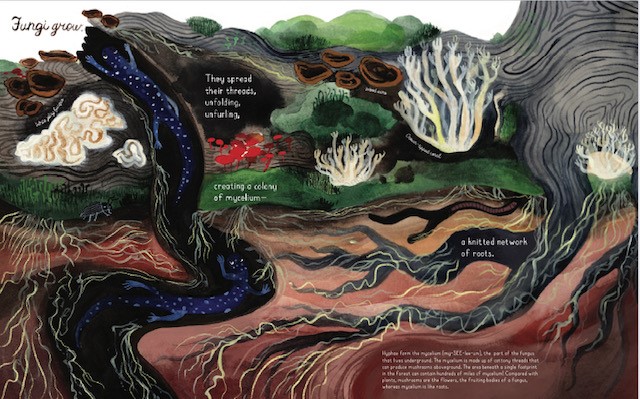
Andrea: I grew up in farm country, too, but have never slapped a cow patty! 😆 Both Thank a Farmer and Fungi Grow are written in free verse, is that correct? You also use many poetic devices throughout both texts, including alliteration, assonance, and onomatopoeia. Do you have favorite devices and how do you decide which ones and when to use them when writing free verse or other poetic forms?
Maria: I would characterize it as free verse. I’m not really sure if I consciously decide what kinds of devices to use—I sort of hear the lines forming in my head as I am drafting and when I am in the so-called zone. When I revise, I do pay careful attention to the sound, and line breaks, and white space since picture books are meant to be read aloud. I gravitate towards assonance and this kind of flowing rhythm, since I love the sounds of the internal rhymes, and the occasional rhyming couplet. In general, I am not a fan of writing that uses a strict pattern (such as a narrative or piece of writing that is exclusively written in rhyming couplets, since I feel like this type of writing tends to be dictated by the rhyming pattern itself, rather than the idea or emotion, if that makes sense).
I am a big fan of using concrete and vivid verbs in all of my writing. A strong verb is concise, precise and is able to paint pictures, evoke emotions, store sounds, and the sound of those verbs is crucial when writing lyrically. There is nothing that’s quite as effective and evocative as a verb that can create an image as well as a feeling through its flowing and sonorous syllables.
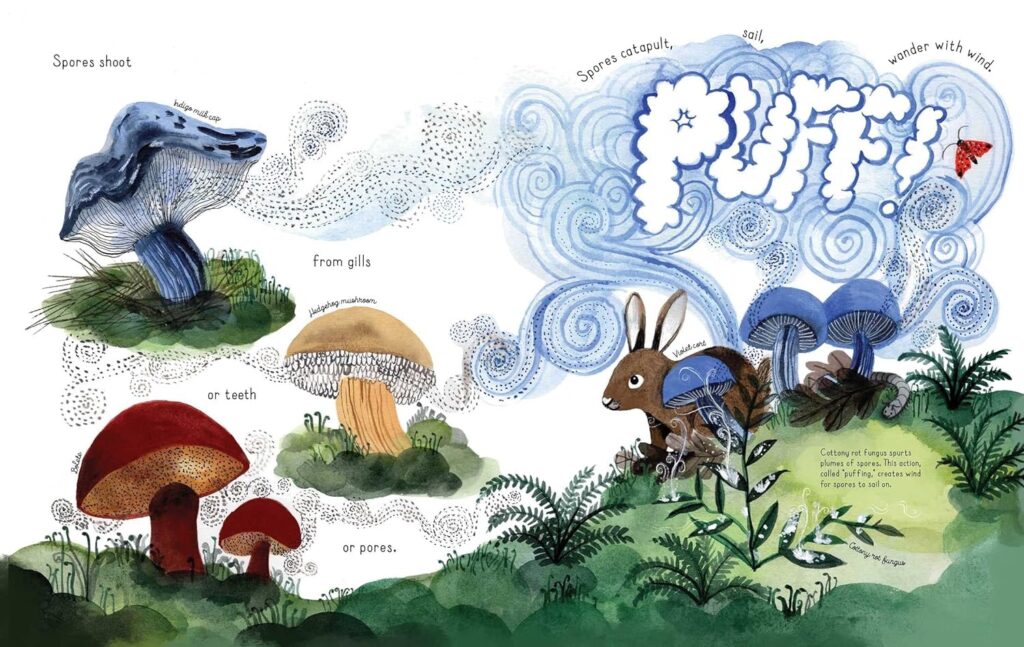
Andrea: I completely agree with you about strong verbs! The refrains in both books are so effective and evocative. Could you tell us about the structures of both books and whether the refrains for each helped you figure out the structure, or was it the other way around? Also, I’d love to hear more about the different layers of text in Fungi Grow and why you decided to incorporate the more technical information on each page instead of in the back matter.
Maria: Thanks, Andrea 😀.
For THANK A FARMER, I did a ton of research on all kinds of farming, and my first discovery draft was a huge hodgepodge of information that I had to sort through to find pattern and shape. It’s not unlike sculpting—you start with a blob, and you chip away at it until a pattern emerges. Once I came up with the “thank a farmer” opening and closing refrains for each spread it helped me to pare and hone and polish the material and discard things that no longer fit (some of which ended up in the back matter).
My discovery draft for FUNGI GROW focused on mushrooms—in fact, it was initially called MARVELOUS MUSHROOMS. But in the end I really wanted to explore the underground world of fungi, the magical and mysterious mycelium, so upon revising, I came up with “fungi grow” as a refrain, and then it evolved into a natural type of life cycle structure, beginning and ending with spores, the “sort of” seeds that form into hyphae and mycelium and eventually fruit into mushrooms.
I love using main text that is spare and poetic while incorporating STEM language. Some scientific language, ideas and phrases can in and of themselves be quite poetic. The use of white space gives readers the chance to reflect and really pay attention to the sound of the language as it is being read aloud. Science and poetry really complement each other quite well—it’s imagistic and ideas can be distilled and pared down to their essence. The sidebars (or layered text) is where I can add more specific scientific information and elucidate it in detail. I had a ton of information and so the back matter is quite extensive too, even with all of the sidebars throughout. Plus, I am a back matter nerd 😀.
Andrea: That’s fascinating about science and poetry complementing each other — I hadn’t thought about it that way before. I’m also a back matter nerd, so I love all the info you included in both books. Speaking of all the info, I’m always interested in how authors winnow down the cornucopia of information, especially on such broad topics as farmers or fungi. How did you choose which foods/crops to highlight in Thank a Farmer and which of the many species of fungi to focus on in Fungi Grow?
Maria: Cornucopia is an apt word for both of these projects! In the beginning it’s always quite overwhelming to figure out where to begin, what to/not to include.
As I mentioned above, the THANK A FARMER discovery draft was all a bit of a mess—just trying to collect and assemble all of this information in one place (and it was huge and unruly). One thing that helped was that Simon wanted it to have a more overall geographical feel—like a journey—so that helped me to try and focus and find different kinds of farming and farm workers and cultures/traditions to represent. Since the book is a celebration, and is literally about giving thanks one thing was an easy omission for me. I am an animal lover, and have long been a vegetarian. I just could not celebrate meat farming—even so-called “humane” small, family farms, so that was an easy thing to cut. I did end up including dairy farmers though, perhaps as an unconscious nod to my Italian ancestors.
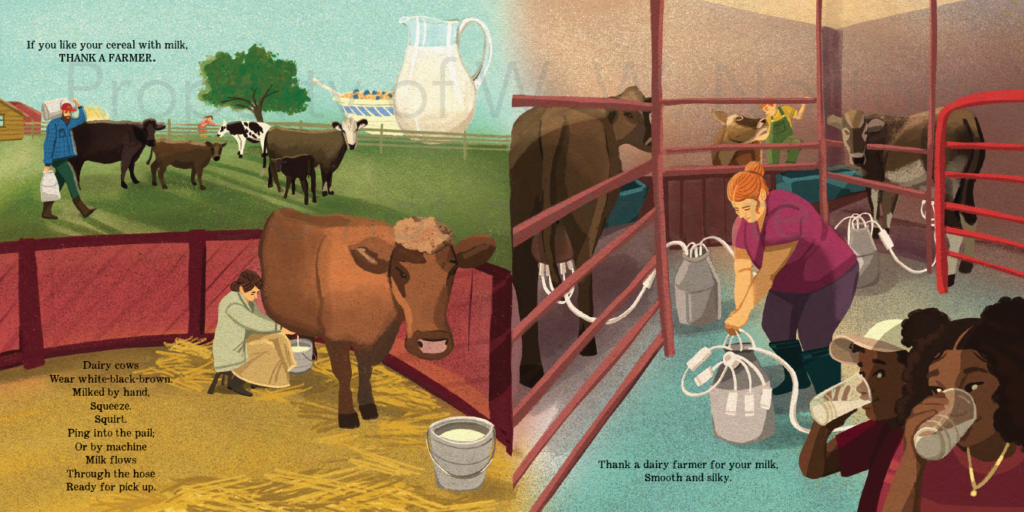
Growing up in NH, and living across from a maple sugar house was wonderful—the smell of those cotton-candy clouds in the late winter air was so inviting, but I also wanted to pay tribute to and honor indigenous cultures and the origins of maple syrup collection. It was important to include foods like rice that are a staple in many different kinds of Asian, Latin American and African cuisines that are also part of the American experience, and peanut butter and jelly too. It’s a farm-to-table kind of book, and Monica threaded the image of a family at a table throughout, and I also had in mind the democratic idea of a table—as an invitation and symbol that all are welcome as I wrote.
There are so many different types of fungi and cool mushrooms—I tried to be as comprehensive as I possibly could, and made a selection of the ones that I found most fascinating. The book is a celebration of all kinds of fungi and mushrooms, from their wild and wonderful names (velvet foot! Witch’s butter! Bleeding tooth! Destroying Angels!) to their ability to digest plastics and petroleum and other chemical and biological waste, and their medicinal and deadly properties too.
For example, in the spores section, I wanted to include the kind of fungi that actually creates its own wind, called puffing, to allow its spores to spread further. Or with the melanistic fungus humorously dubbed “Hulk Bugs” since it’s thriving on radiation at Chernobyl. I was also intrigued by parasitic fungi like cordyceps, popularized in the recent TV series, “The Last of Us,” though the manuscript was written prior to the airing of the series. It basically zombifies an ant, taking over its brain until a mushroom pops out of its head to produce more spores and infect the ant colony below—truly other-worldly stuff!
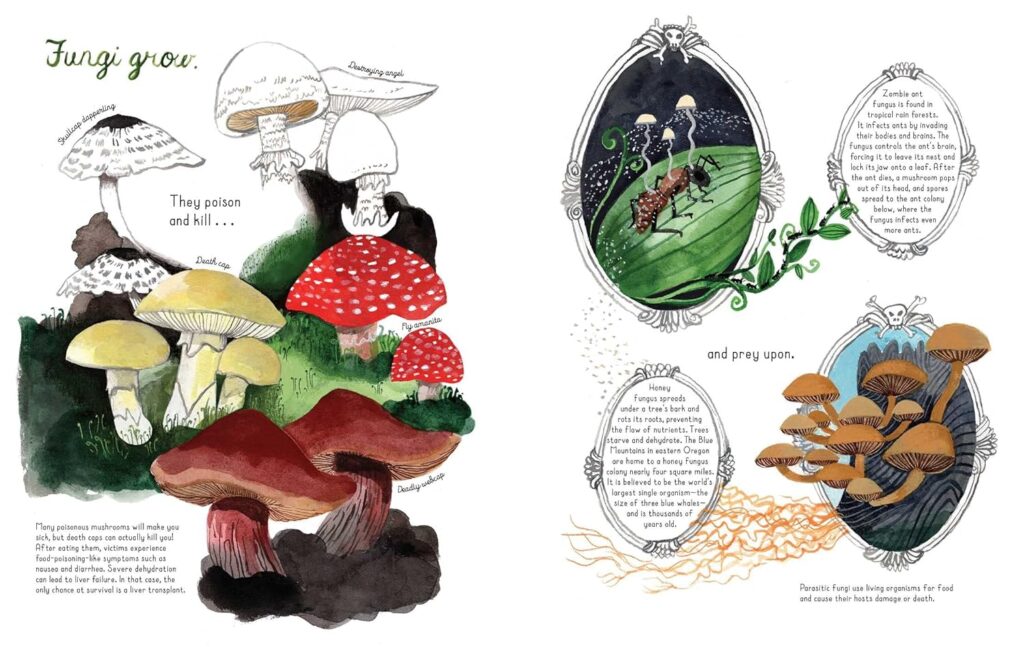
Andrea: Zombifying fungi – perfect for a Halloween post! Let’s talk about the illustrations. Both your illustrators did an amazing job – the art is so lush and vibrant! Both books are such beautiful tributes to plants and wildlife that nourish and enrich our lives. As picture book authors, we rely on the illustrations to convey a lot of information. Diana Sudyka also incorporated some of the onomatopoeia in Fungi Grow into the illustrations themselves, which is really cool. Did you include art notes in either of these manuscripts? How much did you collaborate with the artists?
Maria: Agreed! Aren’t we lucky as picture book authors to work with such talented and visionary folks? (Yes! So incredibly lucky! ~A) There is nothing better than seeing those first sketches! As a picture book writer, I want to leave space for the illustrators to work their magic and bring their visual voice to the text, so my notes tend to be for logistical purposes and/or to ensure technical/scientific accuracy as best as I possibly can.
I love Monica’s warm, inviting and earthy art for THANK A FARMER! I had mostly technical notes on the type of farm equipment portrayed such as the combines, bank out wagons for collecting grains and tree shakers and that sort of thing. We also wanted to ensure that we got the positions of the polers and knockers correct in the wild rice section. The other note I had was to end with a farmer’s market image, but my favorite thing is how Monica incorporated the family and table image into many of the spreads—it’s very celebratory and joyful and full of gratitude.
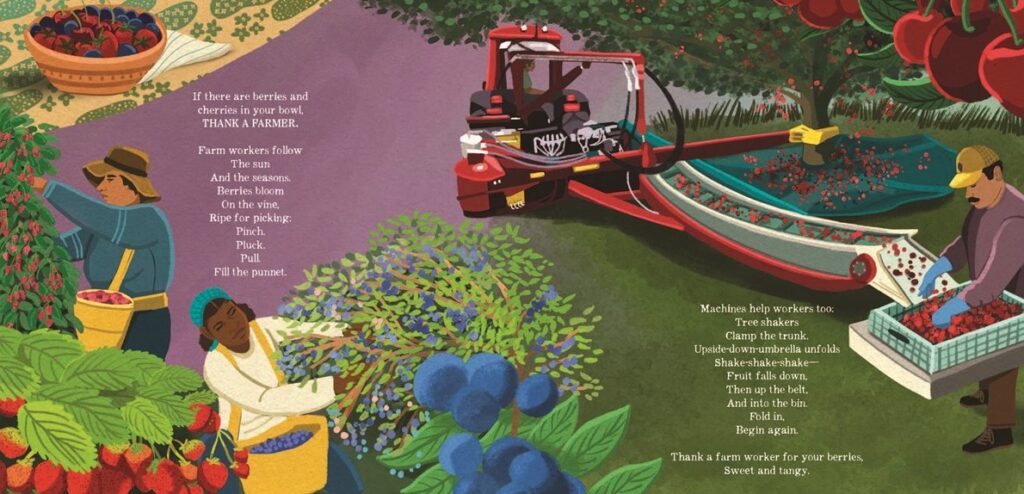
I love how Diana synthesized the onomatopoeic text and blended it with the art so beautifully! The words were mine, but her artful visualization brought them to life. Again, my art notes were more scientific and mycological in nature—various specifications about the type of fungus or mushroom that was described when it was a specific one, like bird’s nest or stinkhorn mushrooms, for example. There were also sections on mushrooms that were more general and open—I used vivid verbs and very spare text to suggest energy and vitality, but no particulars were mentioned.
This was the only text for the entire spread: “Mushrooms bewitch,/beguile,/and multiply.”
And from it, Diana created this! Stunning, right? (Absolutely amazing! ~A)
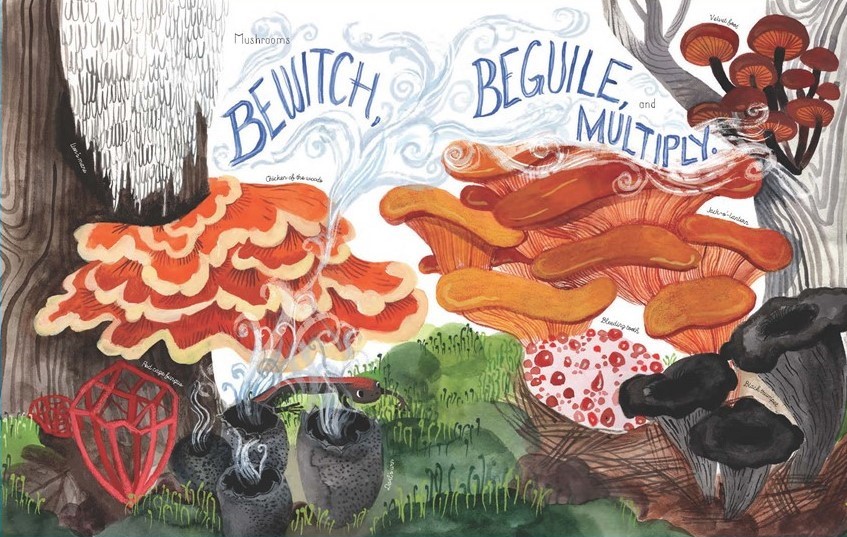
It’s crucial that we picture book writers give illustrators, our co-creators, the space to work their wonder, and not cramp their style.
Andrea: I couldn’t agree more. I’m so thankful for every illustrator’s vision that brings magic to a text. Thanks so much for sharing your new books with us, Maria! Where can folks find you on the non-woody World Wide Web? Can you tell us what’s next for you?
Maria: My next dog book releases on December 19th, in time for the howlidays this year, TO DOGS, WITH LOVE, with adorable doggie art by Ishaa Lobo who’s based in the UK.
This is my website, with lovely landing page art by Hannah Salyer. Her beautiful picture book, ANCESTORY, released earlier this year. We’re doing a book together called RAIN AND THE READING HORSE, coming from Clarion Books in spring 2025.
You can find me on these social media platforms (for now!):
Instagram: @gianferrari_maria_author
Twitter/X: @Gianferrari_M
Facebook: mariagianferrari
I’ll also be at the NCTE 2023 Conference, “Conexiones,” this year on two panels, with FUNGI GROW & THANK A FARMER signings:
*Friday, Nov 17th at 12:30 PM: “Interconnectivity, Immersion, Connection, and Collaboration in Nonfiction” Roundtable
* Signing 3-4PM: FUNGI GROW, Simon & Schuster/Beach Lane
* Saturday, Nov 18th at 8:15 AM: “2023 Notable Children’s Books in the Language Arts” (Ice Cycle)
* Signing 4:30-5:30PM: THANK A FARMER, Norton Young Readers
So pop by and say hello if you’re there!
Thanks again for featuring THANK A FARMER & FUNGI GROW here, Andrea!
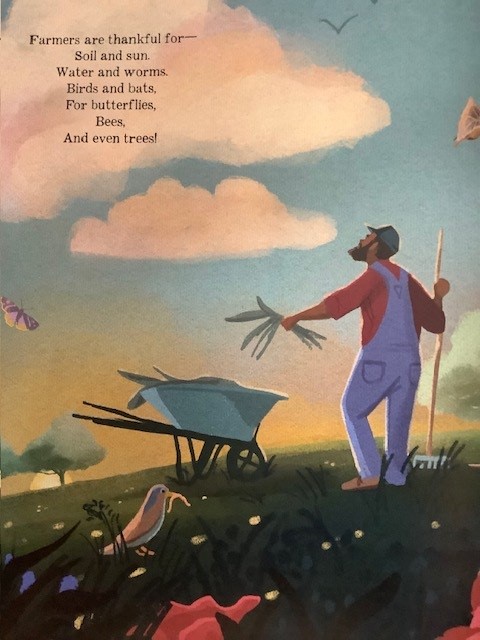
Andrea: I’m so thankful for you and your books, Maria!
Maria is giving away copies of both Thank a Farmer and Fungi Grow to one lucky winner! U.S. addresses only, please. Comment below by Nov. 15th to enter.
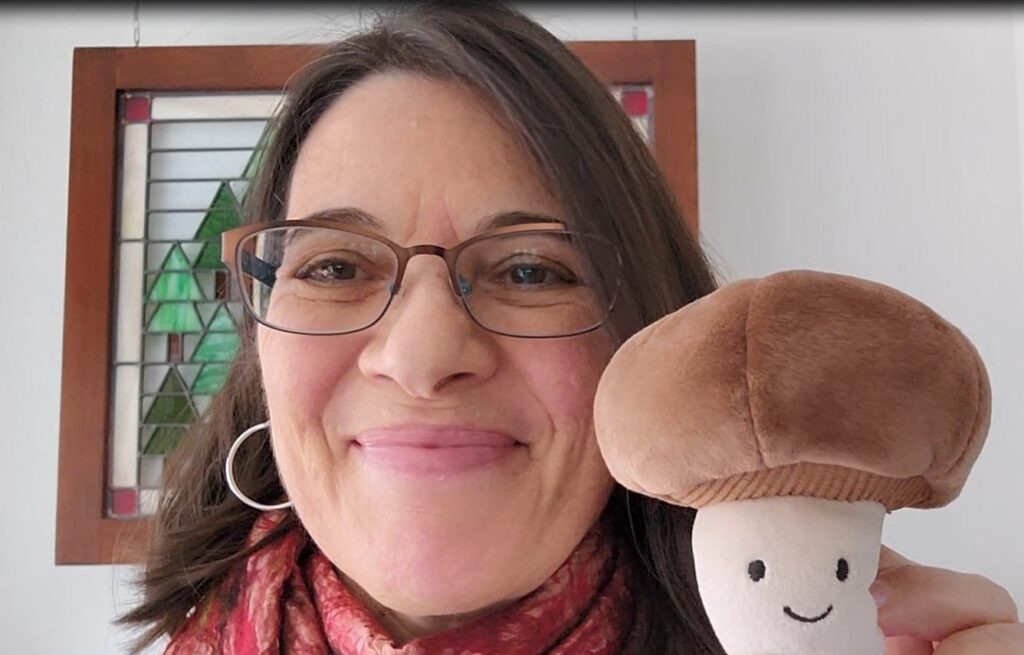
Maria Gianferrari is a picture book reader/writer, tea-drinker, dog-lover, and birdwatcher with an MA in Creative Writing and a Ph.D. in English. Maria writes books that honor our bonds with creatures both domestic and wild, and that celebrate urban ecosystems and the natural world around us. Maria’s most recent titles include Being a Cat: A Tail of Curiosity, You and the Bowerbird, Thank a Farmer, Fungi Grow, and the forthcoming To Dogs, With Love. She lives with her family in Massachusetts and shares her backyard with bobcats and bears, coyotes and deer, wandering wild turkeys, legions of squirrels and chipmunks and the occasional skunk and opossum.

Monica Mikai is an author and illustrator who strives to create art that generates emotion, comfort, and wonder. She grew up in Harrisburg, Pennsylvania—a small city surrounded by farmland. Monica now lives in Virginia, where there are currently 43,225 farms.
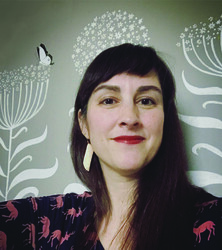
Diana Sudyka grew up hearing stories of her grandfather, an ardent forager, bringing home chicken of the woods and maitake mushrooms for meals. Her favorite edible mushroom is the delicious morel that popped up in her yard last spring. Diana lives with her family in Evanston, Illinois.

Thank you for sharing!
🙂
I love when educational books are fun!
The best kind!
Thanks for the inside look at both of these delightful books. Congratulations, Maria!
Thank you for the inside story of these delightful books, Maria. Congratulations!
Thanks, Carrie 🙂
Both of these books look delightful! I can’t wait to read them. Congrats to all of you!
Thanks so much, Angie! I hope you enjoy them (I know you will LOVE the art for both!)
I can’t decide which book I want to read first. Such great topics and illustrations.
🙂
Magical!
And I just remembered that it’s your birthday, Cathy, so Happy Hallo-birthday!
Andrea and Maria, what a delightful interview!!! Thank you. And congratulations on these beautiful, beautiful books, Maria. Kids will eat them up! And it is wonderful to show kids where their food comes from. We love supporting our local farmers.
I love how accessible you make the wonders of nature. I, too, love mycorrhizae and seriously thought about studying them when I started plant pathology. But life led me to a different path. I started foraging with my kiddos while living in WA. It’s plenty wet in the Pacific NW and we were close to the woods, so it was perfect.
I agree, Vidaya–it’s such a fascinating & mysterious world. I love the temperate rainforest climate of the PNW and all the beautiful conifers! You must have seen some beauties–are you still there?
We moved to SC twelve years ago and loving it even though it’s a completely different environment. The marsh/swamp ecosystem is amazing. I love the live oaks and cypress forests; discovered lovely chanterelles. Driving diagonally across the country you get a sense of the vastness and tremendous variety of landscapes. So beautiful.
Zombie fungi! That’s fascinating and also awesome for today. I can’t wait to read both of these books. I grew up around farms but never slapped cow patties. I’ll have to investigate this too. Thank you for the interview!
Ha! I hadn’t even thought of that, Danielle! Very appropriate for Halloween :).
Slapping cow patties was a lot of fun. I’m one of those rare people who actually likes the smell of manure :).
These are such wonderful books! Thank you for sharing your talent and insight, Maria!
Thanks, Rose 🙂
Such wonderful books! Thank you for sharing your talent and insight, Maria and Andrea.
Love both these books! Thanks for the great interview (and no need to enter me in the giveaway.)
Thanks for the kind words, Buffy! Looking forward to reading your latest 🙂
I absolutely love both of these books so much! Congrats to Maria, Monica, and Diana for their beautiful creations!
Thanks, my dear, Deb! I miss you!
Maria, you are always an inspiration…from your beautiful picture books to these interviews and peeks into your process. Thank you!
How sweet of you to say, Patricia–thank you so much <3!
Love the processing of both books!
Anything Maria writes is amazing and these book look like fantastic stories for any nonfiction unit in the classroom.
nice images
A wonderful book with fabulous reviews!
So excited to see both of these books, particularly Thank A Farmer, as I grew up on a farm!